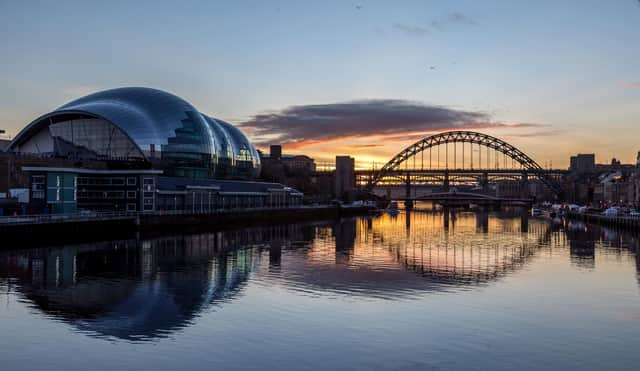Dani Garavelli: The past really is another country


That’s why my husband and I never went back to Newcastle. For five happy years, we stalked its streets, gawped at its bridges, and supped in its hostelries. We learned to love stotties and the Toon, and to speak Geordie, until words such “wey ay” and “divvent” rolled off our tongues.
We worked long hours and spent our days exploring: coastlines and castles; walls, both Byker and Roman. We bought our first house – a small terraced property on the wrong side of Jesmond – and stripped its wooden floors. We transported an over-sized wardrobe from an antiques shop in Hexham, then threw a party at which we press-ganged our guests into carrying it up the stairs.
Advertisement
Hide AdAdvertisement
Hide AdThen, at the tail end of 1995, we loaded our possessions into the back of a van, and drove off to start a new life in Glasgow. I cried so hard on the journey that, by the time we unloaded, I could barely feel my face. I cried again when the jobs we moved for evaporated, and then on and off throughout the bitterest winter in Scottish history. The cold froze the pipes and fractured my heart.
Eventually, spring arrived. The ground and the pipes thawed. We found new jobs, and made new friends. For a while, we travelled back and forth, but, after the house was sold, we stopped. Instead, we hung a photograph of the Tyne Bridge in our hall, packed our memories away in a box marked “The Newcastle years”, and set about the business of fully-fledged adulthood.
Once the past has been hermetically sealed, it’s risky to tamper with it. As the photograph in our hall faded, our memories burned more brightly. To expose them to air – to reality – might cause them to rot. I knew, too, that Newcastle was casting off its dowdy post-industrial clobber, and slipping into something shinier. A new bridge had been built; the Baltic flour mill was converted into an art gallery. To go back would be a test of fidelity. What if we were tempted to trade the Newcastle we once loved for a younger, friskier model?
And so we stayed away – until October when a work project sent us tumbling through time. One Sunday morning, we retraced our old route, down the M74 and across the A69, past all our old haunts. Because, back then, I was a crime reporter, I assumed the role of a dark tourist guide.
At the sign for Ovingham, I squealed: “Remember the siege.” At the sign for the MetroCentre: “Remember the IRA firebombing.”
On arrival, we visited the house in Jesmond. A window cleaner was high on a ladder propped against its walls. “Twenty-seven years ago, this was ours,” I yelled up at him. “Howay, lass,” he replied, “nowt much has changed.”
He was sweet but disingenuous. Almost everything is altered: the infrastructure, the industries, the politics. With its regenerated waterfront, Newcastle has been transformed from the birthplace of ram-raiding to a glistening university town.
Many old buildings are still standing, though. That’s something I realised as we wandered round: how little of my surroundings I had taken in as I scuttled from job to job; night out to night out. Fiercely ambitious, I was forever focused on the next story. I didn’t pause to wonder at the Cathedral or the Co-op building. Now, I craned my neck to gaze at all the columns and corbels, the spandrels and spires.
Advertisement
Hide AdAdvertisement
Hide AdWe hooked up with friends who had gone on living in the North East. In swish new restaurants we retold the old stories; in hoary old bars we caught up with their news. It was a relief to discover past affections lingered; that we still shared common ground.
Yet I suspect a personal reckoning awaits. Another epiphany: the Newcastle years were not perfect. Some bad things happened, and, though they were not my fault, people got hurt. Nor was I always the journalist I aspired to be. Eager to prove myself tough as the lads, I covered crime without covering the causes of crime.
In the early 1990s, the city was rife with juvenile offenders whose antics were glorified under the guise of being condemned. “Rat Boy” gained his nickname because he was small enough to hide out in ventilation shafts. Where is Rat Boy now? Still breaking and entering. A few years ago, his defence barrister told a court: “There was a period when he was having difficulties in his life, and he was excluded from school at 11.” Not a hardened villain, just one more wee boy whose needs went unmet.
I hope to spend more time in Newcastle soon. I am looking forward to forging a more grown-up relationship with the city than the one I enjoyed in callow youth. I want to look at it through older eyes. To explore its many angles; understand its shifting moods.
There is much to be said for being middle-aged – well, that’s what I tell myself. I like to think I’m kinder now; more thoughtful, even. Yet, who am I kidding? And what wouldn’t I give for just one more trip to that vanished land of misplaced confidence and limitless possibilities?
Comments
Want to join the conversation? Please or to comment on this article.